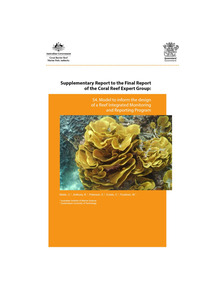Please use this identifier to cite or link to this item:
https://hdl.handle.net/11017/3566Supplementary report to the final report of the coral reef expert group: S4. Model to inform the design of a Reef Integrated Monitoring and Reporting Program

View this entry
Full metadata record
| DC Field | Value | Language |
|---|---|---|
| dc.contributor.author | Mellin, C. | - |
| dc.contributor.author | Anthony, K. | - |
| dc.contributor.author | Peterson, E. | - |
| dc.contributor.author | Ewels, C. | - |
| dc.contributor.author | Puotinen, M. | - |
| dc.date.accessioned | 2020-02-27T04:53:30Z | - |
| dc.date.available | 2020-02-27T04:53:30Z | - |
| dc.date.copyright | 2020 | en |
| dc.date.issued | 2020 | en |
| dc.identifier.isbn | 9780648589280 | en |
| dc.identifier.uri | http://hdl.handle.net/11017/3566 | - |
| dc.description.abstract | [Extract] This project developed a model to inform coral reef monitoring and management under the Reef 2050 Integrated Monitoring and Reporting Program (RIMReP) and the Reef 2050 Long-Term Sustainability Plan (Reef 2050 Plan). The model combines spatial statistical analyses with a mechanistic understanding of coral community dynamics. The purpose of the model is to analyse coral status and trend, and to guide the design of a coral monitoring program that most effectively captures these dynamics in space and time. This model uses per cent cover of hard corals and benthic composition as key indicators of reef state. Input variables include environmental data (e.g. temperature, salinity, sediment covers) and disturbance history (e.g. tropical cyclones, bleaching, water quality and outbreaks of the crown-of-thorns starfish). The model is calibrated against 20 years of in situ coral monitoring data and remotely sensed observations (1996-2015). A dual classification of all Great Barrier Reef (Reef) reefs was established based on (i) their benthic community composition and (ii) their coral cover trajectory over the 1996-2015 period, as a potential tool to stratify the future reef monitoring design. Both classifications, along with model outputs of coral cover, are available as a set of spatial layers (0.01 degree resolution). | en |
| dc.description.abstract | An accessible copy of this report is not yet available from this repository, please contact elibrary@gbrmpa.gov.au for more information. | en |
| dc.publisher | Great Barrier Reef Marine Park Authority | en |
| dc.relation.ispartofseries | Reef 2050 | en |
| dc.relation.ispartofseries | Coral Reef Expert Group (RIMRep) | en |
| dc.rights | © Commonwealth of Australia (Australian Institute of Marine Science). This document is licensed for use under a Creative Commons Attribution-NonCommercial 4.0 International licence with the exception of the Coat of Arms of the Commonwealth of Australia, the logos of the Great Barrier Reef Marine Park Authority and the Queensland Government, any other material protected by a trademark, content supplied by third parties and any photographs. For licence conditions see: https://creativecommons.org/licenses/by-nc/4.0/ | en |
| dc.subject.other | Reef Ecosystems & Marine Species | en |
| dc.title | Supplementary report to the final report of the coral reef expert group: S4. Model to inform the design of a Reef Integrated Monitoring and Reporting Program | en |
| dc.type | Report | en |
| dc.subject.asfa | Literature reviews | en |
| dc.subject.asfa | Surveys | en |
| dc.format.pages | 64 | en |
| dc.contributor.corpauthor | Australian Institute of Marine Science | en |
| dc.publisher.place | Townsville | en |
| dc.relation.connectiontogbrmpa | GBRMPA published this item | en |
| dc.subject.category | Processes | en |
| dc.subject.category | Leading environmental practice | en |
| dc.subject.location | Reef-wide | en |
| dc.keywords | Reef 2050 | en |
| Appears in Collections: | Ecosystems | |
Files in This Item:
| File | Description | Size | Format | |
|---|---|---|---|---|
| Coral Reef Supplementary Report 4.pdf | Main report (PDF) | 6.2 MB | Adobe PDF |  View/Open |
This item is licensed under a Creative Commons License

